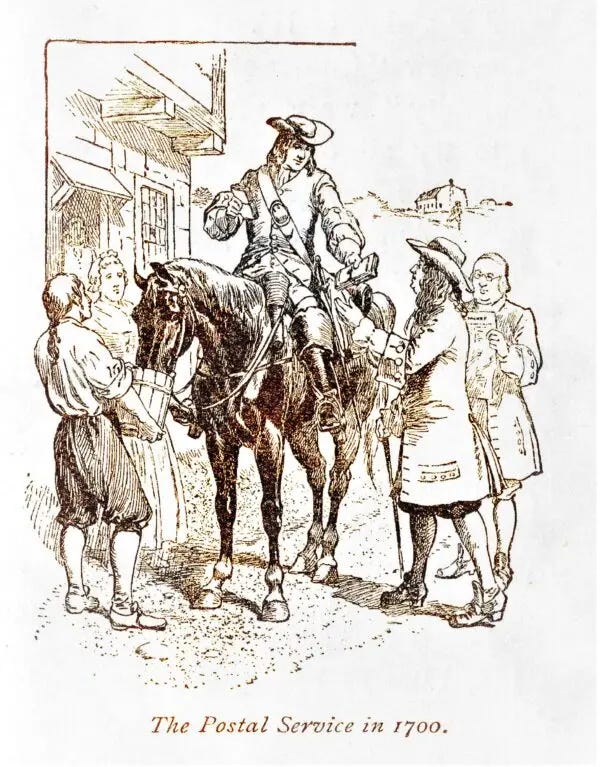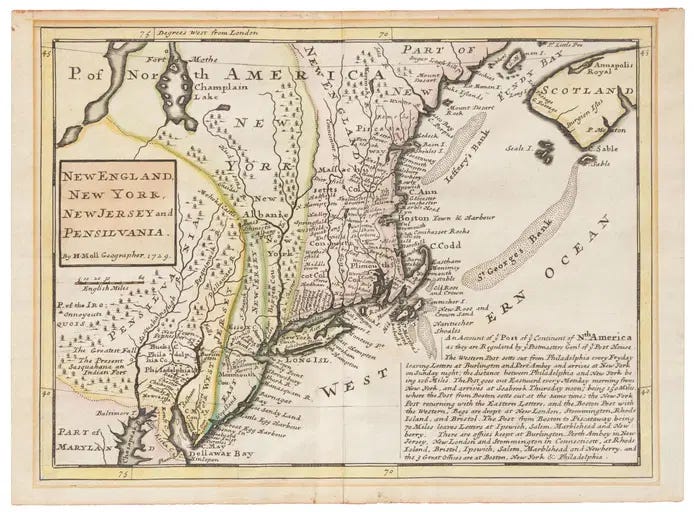I have long been a fan of ‘snail mail,’ the practice of writing letters on paper. Using envelopes and stamps, we send tangible evidence of affection to family and friends. However, our mailboxes do not provide the same sort of thrill as in olden days; many approach it every day with a chagrin.
It seems that, lately, we receive junk mail and advertisements more often than letters. We traded all of that for the speed and convenience of instant messaging and e-mail.
From the beginning, there was more to the post office than bills and catalogues. It was important to the growth of America.
In her fantastic book, How the Post Office Created America, Winifred Gallagher tells the story of our Post Office. This story is far more exciting than I expected. Today, a walk to the mailbox can be a waste of time (and a disappointment, when bills arrive).
You might see your mailbox in a new light, once you learn how the Post Office kept us together as a nation. Before the explosion of catalogues and coupons, colonists and revolutionaries depended on the post.
If America was a body, the post offices were her veins. Mail sent life to little towns as they were established. The post office kept this newly independent body running, united, and healthy.
Benjamin Franklin, Postmaster General
A post office did exist before the American Revolution. It belonged to the British government, and one of its purposes was to keep the colonies in check. (It’s no coincidence that the Stamp Act was one of the ‘last straws’—sparking rebellion in colonists who were already disgruntled).
Benjamin Franklin seemed to have been involved in many things, but I wasn’t aware of his contributions to the post. He was certainly a celebrated scientist and scholar. I learned from Gallagher’s book that he had also been America’s Postmaster General.
Appointed in 1753, Franklin served as overseer for all existing post offices in the colonies. He was given the ability to appoint new postmasters in small towns.
Franklin, ever the innovator, had ideas for streamlining the process, ensuring that letters reached their destinations faster.
I quote from Gallagher’s book:
At a time when overland travel was a grueling ordeal, he personally surveyed and strengthened the sketchy system that connected, albeit erratically, the widely scattered, culturally diverse provinces from Falmouth, Maine, to Charleston, South Carolina. He made many improvements, from plotting more efficient routes marked with milestones to speeding up delivery; round-trip service between Boston and Philadelphia was cut from six weeks to three, and one-way service between Philadelphia and New York City to a mere thirty-three hours.
The post office was not only important for delivering letters. Vital newspapers traveled by post, as well. Newspapers helped people in remote places keep up with what was going on in their shifting world.
Benjamin Franklin was also the editor of his own newspaper. During the French and Indian War, Franklin used the post and his newspaper to begin rallying troops:
Just a month before the Albany Congress, Franklin’s Pennsylvania Gazette had debuted America’s first political cartoon. The simple drawing showed a snake that had been cut up into pieces, signifying the colonies, and the caption read JOIN, OR DIE. The immediate reference reflected Franklin’s concern over the need for the English provinces to unite against the French in the looming colonial wars. On a subtler level, however, the sketch invited a provocative question: Why stop there? Within a generation, Franklin and the post would be at the center of a revolution.
Benjamin Franklin’s Print Shop
The first chapter of Gallagher’s book tells us about Benjamin Franklin’s early years. This includes his work as the owner of a print shop. Such facts are crucial for understanding important figures, but they’re not often taught in history class.
I enjoyed reading about these details, because they added color to his image in my mind. They explained how he was largely a self-made man. He did have various patrons, but worked hard all the same.
Benjamin Franklin aimed high, and this reflected in his work as Postmaster General. He was not content to settle for a flawed post system.
I’d love to offer some context about his print shop, as well. Such was its success that the British government offered him a promotion:
Franklin went on to open his own print shop on Philadelphia’s bustling Market Street and prosper. … In 1737, Britain recognized the enterprising printer’s merits by appointing him Philadelphia’s postmaster, and in 1753, he was promoted to the important position of joint postmaster general for all the North American colonies.
Benjamin Franklin worked hard to improve the Post Office system. However, this service had not yet finished evolving.
Since the country was growing at a fast pace, its Post Office was in constant need of fine-tuning. As settlers began to move west, postmasters faced new challenges. They needed a postal service that would connect settlers with communities they were leaving behind.
This meant new Post Offices and improved roads to get to them. The country was growing; new veins were needed in order to keep her alive.
The Value of Farmers
It was important for farmers to make their homes in distant places. The country depended on their work. It was in the government’s best interest to make them as comfortable as possible. The least that could be done was ensure that their mail would arrive.
This would not be a simple matter. After the war, it was difficult to coax all thirteen states to agree on a road system. They might have fought for independence together, but a sense remained that they were thirteen different bodies. Not all of them had the same priorities.
If roads could not be built to make the process easier, was it possible to improve the system?
Eventually, after several debates among various states, a few postal roads were established. These roads soon became gathering points. Settlers built their homes as near as possible to Post Offices.
The Post Office became a much-needed social spot. Men and women went to gather their mail, enjoying chats with neighbors in the process. This was especially common in places where the post office happened to be inside stores, such as farmers’ markets.
If only it could be like that now! We could look forward to checking local shops for our mail. Even if we didn’t have any mail, it would offer opportunities to talk—not text—with friends.
We would look forward to getting the mail again.
Inventing Home Delivery
As the Post Office grew, more changes arrived.
During the Civil War, it was suggested that the Post Office should deliver news from battlefields to family members. We can understand the reasoning behind this. Countless men died during that war, due to injury and illness. Imagine the constant scenes of heartbreak if, each time a wife or mother visited the Post Office, she were to discover that the man she was waiting for had died.
The Postmaster General of that time insisted that such moments be private. Initially, there was debate about the propriety of having a mailman approach a house where a woman might be alone.
However, the proposal was approved. These families had lost so much; they at least deserved privacy in which to grieve.
Delivering letters was another challenge. This service was new; mailboxes were not yet common. Therefore, the post had to be hand-delivered. If no one was home the first time to receive their letter, the postman held onto it, finished his rounds, and tried again.
Eventually, the envelope was received. If the news was bad, we can imagine that the recipient wished it had never arrived.
Though our Post Office has had many improvements, the process of delivering mail from all over the world continues to present complications. These include transportation, organization, and hiring workers.
Since the Post Office is a service that benefits all of us, many postmasters have tried to find solutions. How the Post Office Created America offers, in its final chapter, a compelling summary of what could be improved.
I read this book on a whim. I never gave much thought to the importance of mailboxes. It is now clear to me that they served as lifelines, holding together a brand-new nation as it grew and explored unfamiliar land. It connected families, fending off a crushing sense of total isolation.
How the Post Office Created America was a fascinating read. If you want to know more about our early history and would like a new perspective, I recommend this book. It is not incredibly long, and it’s an engaging read.
A Brief Course on Revolutionary Painters
Though the American Revolution is recent history when compared to other events, much of it remains a mystery. With no photos to provide clarity, we rely on our imaginations for a good deal of it.










This is so interesting. I think that today, society really lacks a place like the post office where people can gather or see their neighbors on their rounds, etc. thanks for sharing!
One of the most important American civil services, far too many take it for granted. As the culture in the United States continues to favor convenience and speed, this is a great reminder that the post office was once the town water cooler, offering much more than the transactional shipping or receiving.